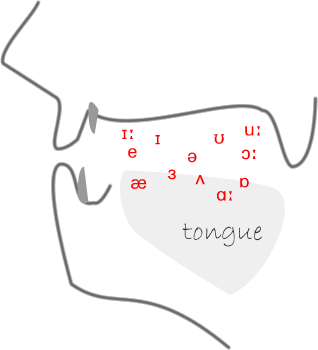
Vowels in the mouth.
The word vowel comes from the Latin word vowis meaning voice. In English we should make the distinction between spoken vowels and written vowels.
In spoken English there are approximately 12 basic vowel sounds (see below); in written English, however, there are just 5 vowels. This means, obviously, that the written vowels can be pronounced in different ways.
Every written word has at least one vowel: a, e, i, o or u. There are a few exceptions such as:
fly, hymn, why
These words use the letter y instead of a vowel. A very few words contain all five vowels in alphabetical order:
facetious, abstemious
Vowel Sounds
In terms of sound production, a vowel is a sound which has an uninterrupted air flow. Compare this with a consonant where the airflow is blocked at some point (for example, by the lips).
The most common sound in English is the vowel sound known as the schwa which is represented in the IPA as /ə/. This occurs in words like
- about – /əbəʊt/
- america – /əmɛrɪkə/
Diphthongs are two vowel sounds said as one. This occurs when the mouth changes shape during production in such words as:
- pie – paɪ
- boy – bɔɪ
The image on this page (top-right) shows a diagram of the human mouth and the approximate position where the various vowel sounds are made. The difference in sounds between the vowels depends on the shape of the mouth and the position of the tongue and lips. For example:
- the sound /ɪ/ in the top left of the diagram occurs with the lips almost closed and the tongue high in the mouth
- the sound /æ/ in the bottom left has the lips more open
- the sound /uː/ in the top right has the lips closed but the tongue flat
- the sound /ɑː/ has the lips open and the tongue flat
- the sound /ə/ is a “neutral” vowel sound with the mouth relaxed and the lips half-open and the tongue in the middle
Teacher Tip: You should practice making these sounds and recognising the position of your lips, tongue and mouth shape whilst you do so. When you are familiar with this you’ll be able to explain the sounds more effectively to your class.
The chart below is a simplified excerpt from the IPA giving the main vowel sounds.

|

|

|

|

|

|
|

|

|

|

|

|

|

|

|

|

|

|

|

|

|



Hi ,,, with admiration, gratitude, respect, and best wishes.
Tiny remark in relation to :
– vowel definition / concept / description
Example : diphthongs & triphthongs: aW = vowel + consonant / aY = vowel + consonant / iYə = vowel + consonant / uWə = vowel + consonant, and so on …
– Initial word / syllable segments
Example : (ﺀ)islam, the(ﺀ)al-gebr-a, (ﺀ)adm-, (ﻫ)ev-e, (ﺀ)allah-, (ﻉ)Arabic
Please do note the difference between (ﻫ) and (ﺡ) – even inEnglish (For example: the Word Messia(ﺡ)
… Where are the problems, then? … (including phonotactics)
Language, knowledge or linguistics? (in a time of science, high-tec, etc.?
– Final word / syllable segments
… Where are the problems? … (including morphotactics)
(New authoritative scholarly publications might appear in the near or distant future with previous centuries dates, claiming someone wrote on such and / or such, a long time ago … That’s not uncommon in the super-developed worlds ! What can one say about the third ?! Not much … really! …).
There are other significant remarks, indeed, but this is just not the time / occasion to address them all.
Merry Christmas & Happy New Year.
Sincerely,
Mohamed Souissy.
Thanks for your comments, Mohamed – and best wishes to you also! 🙂